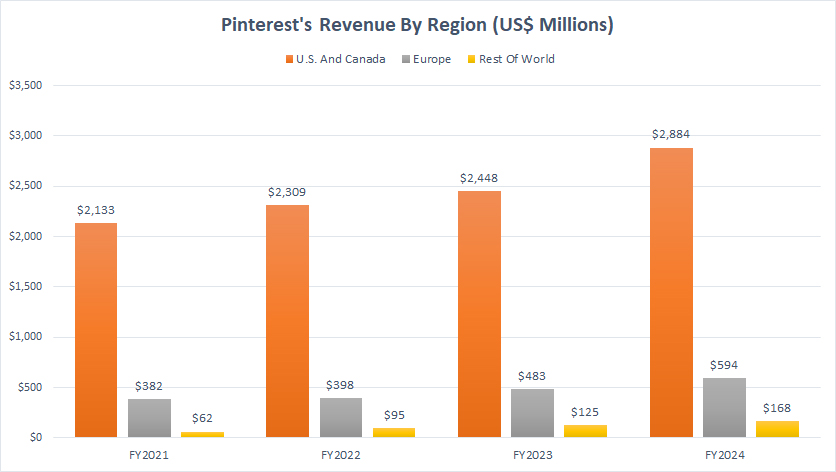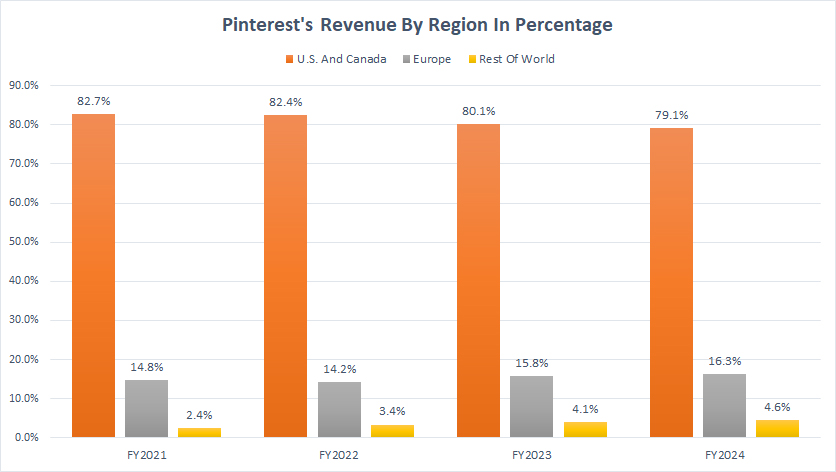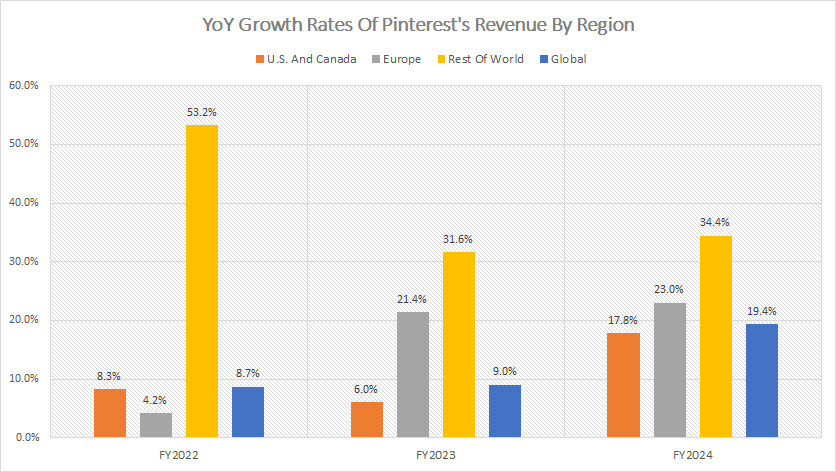
Social media space. Pixabay Image.
Pinterest (PINS), a leading social media platform, has more than 500 million monthly active users globally, according to the company’s latest filings.
That said, this article presents Pinterest’s revenue breakdown according to geographic location. Pinterest derives a significant portion of revenue from North America and Europe.
Pinterest’s North America includes the United States and Canada, while Europe includes Russia and Turkey.
Keep in mind that the revenue distribution by country and region presented here is based on users’ geographic location when they perform a revenue-generating activity.
This allocation differs from the revenue disaggregated by geography where revenue is geographically apportioned based on Pinterest’s customers’ billing addresses.
For revenue distribution according to Pinterest’s customers’ billing addresses, you may visit this page: Pinterest revenue based on customers billing addresses.
Let’s look at the details!
You may find other key statistic of Pinterest on these pages:
- Pinterest profit margin vs Facebook, Snap and Twitter,
- Pinterest vs Meta, Twitter and Snapchat: average revenue analysis, and
- Pinterest vs Meta, Twitter, and Snapchat: R&D comparison.
Please use the table of contents to navigate this page.
Table Of Contents
Definitions And Overview
O2. Pinterest Business Strategy
O3. How Does Pinterest Earn Revenue
Regional Revenue
C1. Revenue From The U.S. And Canada, Europe, and Rest Of World
Regional Revenue In Percentage
C2. Percentage Of Revenue From The U.S. And Canada, Europe, and Rest Of World
Regional Revenue Growth
C3. YoY Growth Rates Of Revenue From The U.S. And Canada, Europe, and Rest Of World
Summary And Reference
S1. Conclusion
S2. References and Credits
S3. Disclosure
Definitions
To help readers understand the content better, the following terms and glossaries have been provided.
Revenue By Region: According to Pinterest, Inc., revenue by region is geographically apportioned based on its estimate of the geographic location of its users when they perform a revenue-generating activity.
This allocation is consistent with how the company’s average revenue per user is determined.
For revenue based on customers’ billing addresses, please visit this page: Pinterest revenue by country (based on customers’ billing addresses).
Users Locations When They Perform Revenue-Generating Activities: From the perspective of social media companies, revenue based on users’ geographical locations when they perform revenue-generating activities refers to income derived from specific regions or countries where users engage in activities that directly generate revenue.
Here’s how this applies:
-
Ad Revenue by Region: Social media platforms often sell targeted advertising, where advertisers pay based on user engagement (like clicks or views) within certain geographic areas. For instance, ad impressions in high-demand markets often yield higher revenue.
-
Subscription Services: If users in specific locations subscribe to premium features or services, the platform can attribute that subscription revenue to those regions.
-
In-App Purchases: Revenue from users purchasing digital goods, virtual currency, or services through the platform is tracked by their geographical location.
-
Regional Campaign Performance: Platforms can evaluate how successful ad campaigns are in different regions and optimize revenue strategies accordingly.
This approach helps social media companies tailor their business strategies, focusing on high-performing regions or developing location-specific offerings to maximize profitability.
Pinterest Business Strategy
Pinterest’s business strategy is centered around being a visual discovery and bookmarking tool that helps users discover new ideas, inspire creativity, and find information through images, GIFs, and videos. The platform operates on a unique model that blends social networking with personalized content curation, allowing users to “pin” content to their boards for later access and sharing with others.
Key components of Pinterest’s business strategy include:
1. **User Growth and Engagement:** Pinterest focuses on growing its user base and keeping users engaged by continuously enhancing its recommendation algorithms, making it easier for users to discover content that matches their interests. The platform encourages user interaction by creating, sharing, and discovering pins.
2. **Advertising and Monetization:** Pinterest generates revenue primarily through advertising. The platform offers businesses and advertisers various advertising products, including promoted pins, video ads, and shopping ads, seamlessly integrated into the user experience. Pinterest’s rich user data allows for targeted advertising based on interests, search behavior, and interaction with content, making it an attractive platform for advertisers looking to reach a highly engaged audience.
3. **E-commerce Integration:** Recognizing the platform’s potential as a driver of online shopping, Pinterest has been enhancing its e-commerce capabilities. Features like shoppable pins, visual search, and product catalogues allow users to discover and purchase products directly through the platform. This improves the user experience and opens up new revenue streams for Pinterest through partnerships with retailers and e-commerce platforms.
4. **International Expansion:** Pinterest has been expanding its global presence by tailoring its platform to cater to users in different regions, optimizing for local content and languages. This strategy aims to grow its user base outside its core markets and tap into new advertising markets.
5. **Investment in Technology and Innovation:** Continuous investment in technology, such as machine learning and artificial intelligence, is a key part of Pinterest’s strategy. These technologies enhance content discovery, improve ad targeting, and create a more personalized and engaging user experience.
Overall, Pinterest’s business strategy is focused on leveraging its unique position as a visual discovery platform to grow its user base, enhance user engagement, and drive revenue through advertising and e-commerce, all while continuously innovating and expanding globally.
How Does Pinterest Earn Revenue
Pinterest generates revenue primarily through advertising, specifically with a model known as promoted pins. Promoted pins are advertisements placed by businesses that look similar to regular pins but are paid for to appear in more prominent positions on Pinterest, such as in search results, home feeds, or category pages, making them more likely to be seen by users. These ads can be targeted based on demographics, interests, and behaviors to reach specific audiences.
Additionally, Pinterest has introduced other revenue streams over the years, including shopping features that allow users to purchase products directly from pins, further leveraging its position as a discovery platform for users planning projects, hobbies, and purchases. This e-commerce integration provides another avenue for Pinterest to monetize its services by either taking a cut from sales made through the platform or charging businesses for enhanced shopping features.
Pinterest also periodically explores new features and services that could potentially open up additional revenue streams, staying responsive to user behavior and market trends.
Revenue From The U.S. And Canada, Europe, and Rest Of World
Pinterest’s revenue by region
(click image to expand)
Pinterest apportions its revenue by region based on its estimate of users’ geographic location when they perform a revenue-generating activity. More information about Pinterest’s revenue by region is available here: revenue by region.
Pinterest’s North American region continues to dominate as its most lucrative market, with sales from this area comprising the majority of the company’s revenue. In financial year 2024, Pinterest generated an impressive $2.9 billion in revenue from the United States and Canada, marking an 18% growth compared to $2.4 billion in fiscal year 2023. This substantial increase underscores North America’s pivotal role in Pinterest’s overall financial success.
Over a longer time frame, the North American region has seen steady growth in its contribution to Pinterest’s revenues. Since fiscal year 2021, revenue from the U.S. and Canada has surged by 38%, rising from $2.1 billion three years ago to the current figure of $2.9 billion. This sustained upward trajectory highlights the consistent demand and effectiveness of Pinterest’s monetization strategies within these markets.
Turning to Europe, the region emerges as Pinterest’s second-largest revenue source. Fiscal year 2024 saw record revenue figures for Europe, with Pinterest generating nearly $600 million, a robust 23% jump from $483 million in fiscal year 2023. Interestingly, this growth rate outpaces the 18% increase seen in North America, signaling an expanding user base and enhanced monetization efforts in European markets. Over the past three years, revenue from Europe has demonstrated even stronger percentage growth compared to North America. Since fiscal year 2021, Pinterest’s European revenue has increased by 55%, climbing from $382 million to $594 million in the latest fiscal period.
The “Rest of World” (ROW) region also recorded noteworthy progress. Pinterest’s revenue from these markets reached $168 million in fiscal year 2024, reflecting a significant 34% increase from $125 million in 2023. The ROW segment has been the fastest-growing revenue source for Pinterest on a percentage basis. Since fiscal year 2021, revenue from ROW markets has nearly tripled, rising dramatically from $62 million to the latest figure of $168 million. This remarkable growth showcases the untapped potential and expanding influence of Pinterest in regions outside its core North American and European markets.
Altogether, Pinterest’s financial performance demonstrates the company’s ability to drive significant revenue growth across its global markets, with particularly strong momentum in emerging regions. These figures not only highlight Pinterest’s ongoing success but also its expanding footprint in both established and developing markets.
Percentage Of Revenue From The U.S. And Canada, Europe, and Rest Of World
Pinterest’s revenue share by region
(click image to expand)
Pinterest apportions its revenue by region based on its estimate of users’ geographic location when they perform a revenue-generating activity. More information about Pinterest’s revenue by region is available here: revenue by region.
The graph above highlights the continued dominance of the U.S. and Canada as its largest revenue-generating regions, while also showcasing the growing contributions from Europe and the Rest of World (ROW) regions. As depicted in the accompanying graph, the share of revenue from the U.S. and Canada reached 79% in fiscal year 2024, representing a slight decrease from 80% in fiscal year 2023.
Over a longer period, from fiscal year 2021 to 2024, this share has gradually declined from 83% to 79%. While still forming the lion’s share of Pinterest’s revenue, this trend underscores a modest shift in the geographic distribution of the company’s earnings.
Europe, on the other hand, has steadily increased its share of Pinterest’s total revenue, signifying the region’s growing importance. In fiscal year 2024, Europe accounted for 16% of the company’s revenue, a notable rise from 15% in 2021. This upward trajectory underscores Pinterest’s successful efforts to expand its presence and improve monetization strategies in European markets. The region’s incremental growth reflects increasing engagement from users and advertisers alike, solidifying Europe’s role as Pinterest’s second-largest revenue source.
Meanwhile, the Rest Of World (ROW) regions, although contributing a relatively smaller portion of revenue, have demonstrated remarkable growth. In fiscal year 2024, ROW regions accounted for 4.6% of total revenue, a significant increase compared to 2.4% in fiscal year 2021. This nearly doubling of the revenue share over three years highlights Pinterest’s expanding footprint in emerging markets. The impressive growth rate from ROW regions underscores the company’s ability to tap into new opportunities and diversify its revenue streams outside of its core markets.
In conclusion, while the U.S. and Canada remain the backbone of Pinterest’s revenue, the rising contributions from Europe and ROW regions indicate a positive trajectory toward geographic diversification. This trend not only mitigates regional dependence but also showcases Pinterest’s potential for sustained global growth.
YoY Growth Rates Of Revenue From The U.S. And Canada, Europe, and Rest Of World
Pinterest’s revenue by region growth rates
(click image to expand)
Pinterest apportions its revenue by region based on its estimate of users’ geographic location when they perform a revenue-generating activity. More information about Pinterest’s revenue by region is available here: revenue by region.
Fiscal year 2024 proved to be a landmark year for Pinterest, showcasing exceptional growth across various regions and cementing its position as a global social media powerhouse. This financial year stands out as one of the most robust growth periods observed between 2022 and 2024, with several key performance metrics reaching their highest levels in years.
Globally, Pinterest achieved a remarkable revenue growth of 19% in fiscal year 2024, the strongest annual growth rate since 2022. This significant uptick highlights the effectiveness of Pinterest’s ongoing strategic initiatives, including enhanced advertising capabilities, user engagement efforts, and platform innovations.
In the U.S. and Canada — Pinterest’s largest revenue-generating regions — the company posted an impressive 18% revenue growth in fiscal year 2024, marking the highest growth rate since 2022. This substantial increase reaffirms the region’s critical role in driving Pinterest’s overall financial performance while reflecting sustained advertiser confidence and a strong user base within these markets.
Europe also emerged as a standout performer in fiscal year 2024, delivering revenue growth of 23%. This growth not only surpassed the rates achieved in earlier financial periods but also outpaced the U.S. and Canada in percentage terms. The strong performance in Europe is indicative of Pinterest’s success in capturing new advertisers, increasing market penetration, and tailoring its offerings to resonate with local audiences.
However, the most striking trend has been the exceptional revenue growth in Rest of World (ROW) regions. Across all financial periods from 2022 to 2024, ROW regions consistently outpaced other markets in terms of growth rates. In fiscal year 2024, revenue from ROW regions surged by an extraordinary 34%, significantly exceeding the growth rates recorded in the U.S., Canada, and Europe. This trend underscores Pinterest’s ability to unlock value in emerging markets, where rising internet penetration, growing digital advertising ecosystems, and an expanding user base have contributed to this rapid growth.
A similar pattern was evident in fiscal years 2023 and 2022, where ROW regions consistently demonstrated significantly higher revenue growth compared to Pinterest’s core markets. This highlights the untapped potential of these regions and Pinterest’s strategic efforts to expand its footprint beyond established markets.
In summary, fiscal year 2024 marked a pivotal period for Pinterest, characterized by remarkable revenue growth across all regions. With the U.S. and Canada maintaining their dominance, Europe showing notable expansion, and ROW regions experiencing exponential growth, Pinterest’s financial trajectory showcases the platform’s ability to adapt and thrive in a competitive global market.
Summary
Essentially, Pinterest is demonstrating a deliberate and effective shift toward geographical diversification. While North America remains the cornerstone of its business, the rapid growth in Europe and ROW regions is signaling a healthy, balanced expansion. The trends also suggest that Pinterest’s investments in emerging markets and Europe are yielding significant returns, positioning it well for continued global growth.
References and Credits
1. All financial figures presented are referenced and obtained from the company’s quarterly and annual reports published on the company’s investor relations page: Pinterest Investor Relations.
2. Pinterest’s business strategies and revenue streams are referenced and obtained from documentations available in All About Pinterest, How Pinterest Businesses Work, Pinterest’s Guides And Education.
3. Pixabay Images.
Disclosure
We may use the assistance of artificial intelligence (AI) tools to produce some of the text in this article. However, the data is directly obtained from original sources and meticulously cross-checked by our editors multiple times to ensure its accuracy and reliability.
If you find the information in this article helpful, please consider sharing it on social media. Additionally, providing a link back to this article from any website can help us create more content like this in the future.
Thank you for your support and engagement! Your involvement helps us continue to provide high-quality, reliable content.



